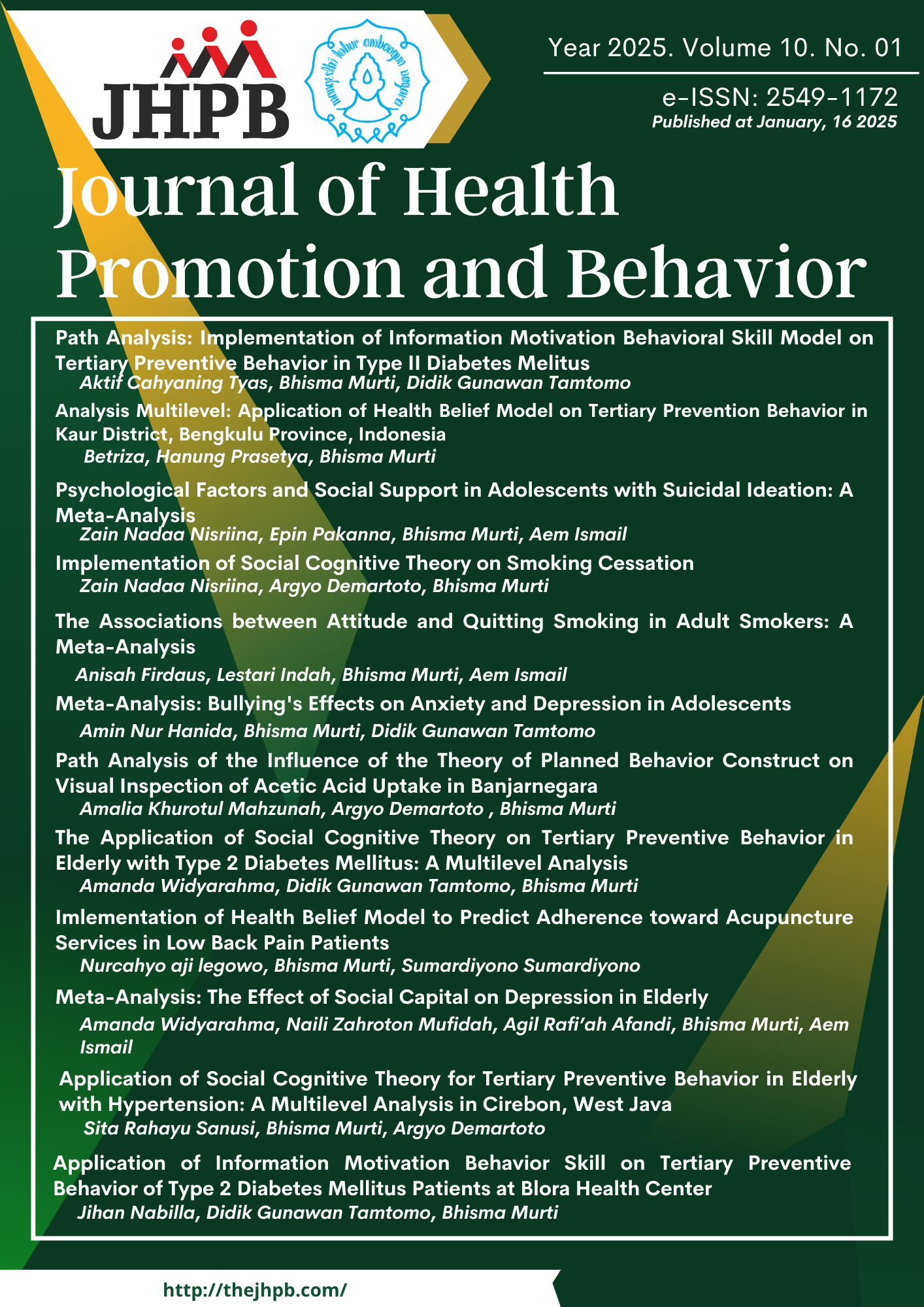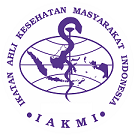Meta-Analysis: Bullying's Effects on Anxiety and Depression in Adolescents
DOI:
https://doi.org/10.26911/thejhpb.2025.10.01.06Abstract
Background: Bullying is a major problem worldwide. Bullying itself is defined as a condition in the form of negative and repetitive behavior, carried out by a person or group of people, the treatment is carried out deliberately and intensely with the aim of hurting physically and mentally. This study aims to analyze and estimate the magnitude of the influence of bullying on anxiety and depression in adolescents.
Subject and Method: The meta-analysis was performed according to the flow of the PRISMA diagram and the PICO model. P: Adolescents, I: Bullying, C: No bullying, O: Anxiety and depression. The search for articles in this study is through databases that include PubMed, Google Scholar, Science Direct and Scopus. With keywords including: "bullying" AND "anxiety" AND "depression" AND "adolescent". Full paper article with cross-sectional study, the subject of the study was adolescents, the measure of the relationship used was adjusted Odds Ratio, the outcome of the study was anxiety and depression. Analysis was done with Revman 5.3
Results: There were 10 articles with cross-sectional designs from the United States, Africa, China, Saudi Arabia, Malaysia, and Australia with a total of 282,799 research samples. A meta-analysis of 10 cross-sectional studies concluded that adolescents who experienced bullying had a 1.98 times greater risk of anxiety than those without bullying (aOR = 1.98; CI 95%= 1.54 to 2.53; A meta-analysis of 8 cross-sectional studies concluded that adolescents who experienced bullying had a 1.85 times greater risk of depression compared to no bullying (aOR= 1.85; CI 95%= 1.37 to 2.50; p<0.001).
Conclusion: Bullying increases the risk of anxiety and depression in adolescents
Keywords:
bullying, anxiety, depression, adolescentsHow to Cite
References
Ambar PY, Meiyuntariningsih T. (2015). Efektivitas group cognitive behavior therapy (GCBT) dalam menurunkan kecemasan menghadapi pelaku pe-rundungan ditinjau dari harga diri pada korban bullying. J. Psikol. Terap. 03(01): 2301-8267.
AlBuhairan F, Abbas OA, Sayed DL, BadriM , Alshahri S, Vries ND. (2017). The relationship of bullying and phy-sical violence to mental health and academic performance. Int J Pediatr Adolesc Med. 4(2): 61–65. Doi: 10.-1016/j.ijpam.2016.12.005.
Anderson JR, Mayes TL, Fuller A, Hughes JL, Minhajuddin A, Trivedi MH. (2022). Experiencing bullying’s im-pact on adolescent depression and an-xiety: Mediating role of adolescent resilience. J. Affect. Disord. 310: 477-483. Doi: 10.1016/j.jad.2022.04.003.
Bowes L, Wolke D, Joinson C, Lereya ST, Lewis G. (2014). Sibling bullying and risk of depression, anxiety, and self-harm: A prospective cohort study. Pediatr. 134 (4): e1032–e1039. Doi: 10.1542/peds.2014-0832.
Bulu Y, Maemunah N, Sulasmini (2019). Faktor-faktor yang mempengaruhi perilaku bullying pada remaja awal. J. Ilmiah Keperawatan. 4(1): 54-66.
Dianovinina K (2018). Depresi pada Remaja: Gejala dan Permasalahannya (Depression in Adolescents: Symptoms and Problems). J. Psi-kogenesis. 6 (1): 69-78. Doi: 10.24-854/jps.v6i1.634.
Dunn HK, Gjelsvik A, Pearlman DN, Clark MA (2014). Association between sex-ual behaviors, bullying victimi-zation and suicidal ideation in a national sample of high school students: impli-cations of a sexual double standard. Women’s Health Issues. 24(5): 567–574. Doi: 10.1016/j.whi.-2014.06.008.
Fang D, Lu J, Che Y, Ran H, Peng J, Chen L, Wang S, et al.(2022). School bullying victimization-associated an-xiety in Chinese children and adoles-cents: the mediation of resilience. Child Adolesc. Psychiatry Ment. He-alth. 16(1): 1–7. Doi: 10.1186/s13034-022-00490-x.
Ford R, King T, Naomi Priest N, Kavanagh A. (2017). Bullying and mental health and suicidal behaviour among 14- to 15-year-olds in a representative sam-ple of Australian children. Aust. N. Z. J. Psychiatry. 51(9):897–908. Doi: 10-.1177/0004867417700275.
Hoertel N, Strat YL, Lavaud P, Limosin FDR. (2012). Gender effects in bully-ing: Results from a national sample. Psychiatry Res. 200(2–3): 921–92-7. Doi: 10.1016/j.psychres.2012.03.036.
Liu X, Peng C, Yu Y, Yang M, Qing Z, Qiu X, Yang X. et al. (2020). Association Between Sub-types of Sibling Bullying and Mental Health Distress Among Chinese Children and Adolescents. Front. psychiatry. 11(5): 1–8. Doi: 10.-3389/fpsyt.2020.00368.
Luo X, Zheng R, Xiao P, Xie X, Liu Q, Zhu K, Wub X (2022). Relationship bet-ween school bullying and mental he-alth status of adolescent students in China: A nationwide cross-sectional study. Asian J Psychiatr. 70(1): 103-043. Doi: 10.1016/j.ajp.202-2.103-04-3.
Marela G, Wahab A, Marchira CR (2017). Bullying verbal menyebabkan depresi remaja SMA Kota Yogyakarta. Berita Kedokteran Masyarakat. 33(1): 43. Doi: 10.22146/bkm.8183.
Muhopilah P, Tentama F (2019). Faktor-faktor yang mempengaruhi perilaku bullying J Psikol Terap Pendidik. 1(2): 99. Doi: 10.26555/jptp.v-1i2.15132
Murti B (2018). Prinsip dan Metode Riset Epidemiologi (5 th ed). Program Studi Ilmu Kesehatan Masyarakat, Sekolah Pascasarjana, Universitas Sebelas Maret.
Peng C, Wang Z, Yu Y, Cheng J, Qiu X, Liu X (2022). Co-occurrence of sibling and peer bullying victimization and depression and anxiety among Chi-nese adolescents: The role of sexual orientation. Child Abuse Negl. 131: 105684. Doi: 10.1016/j.ch-iabu.-2022.-105684.
Razak MAA, Ahmad NA, Abd AFA, Jamaluddin R, Sidik SM, Awaluddin SM, Ibrahim N, et al. (2019). Being bullied is associated with depression among malaysian adolescents: fin-dings from a cross-sectional Study in Malaysia. Asia Pac J Public Health. 31(8): 30S-37S. Doi: 10.1177/1010539-519867796.
Reisert H, Pham D, Rapoport E, Adesman A. (2023). Associations Between Bull-ying and Condition Severity Among Youth With Chronic Health Condi-tions. J Adolesc Health. 73(2): 279–287. Doi: 10.1016/j.jadoheal-th.20-23.-03.004.
Şahin N, Kırlı U (2021). The relationship between peer bullying and anxiety-depression levels in children with obesity. Anadolu Psikiyatri Derg. 22(2): 94–99. Doi: 10.5455/apd.1-3-3514
Tan L, Ganapathy SS, Sooryanarayana R, Hasim MH, Saminathan TA, Anuar MFM, Ahmad FH, et al. (2019). Bullying Victimization Among School-Going Adolescents in Malaysia: Prev--lence and Associated Factors. Asia Pac J Public Health. 31(8): 18S-29S. Doi: 10.1177/1010539519870665.
Tumon MBA (2014). Studi Deskriptif Perilaku Bullying pada Remaja. 3(1): 1–17.
Wilson ML, Bovet P, Viswanathan B, Suris JC (2012). Bullying among adoles-cents in a sub-Saharan middle-in-come setting. J Adolesc Health. 51(1): 96–98. Doi: 10.1016/j.jado-health.-2011.11.024.




